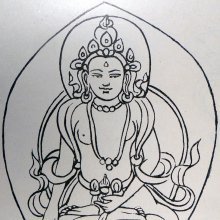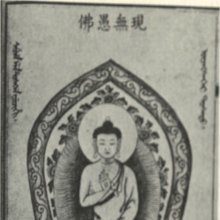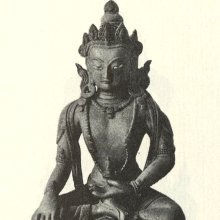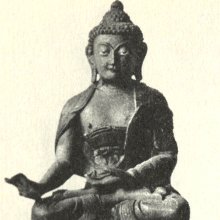Amoghadarshin, Amoghadarśin, Amogha-darshin: 8 definitions
Introduction:
Amoghadarshin means something in Buddhism, Pali, Hinduism, Sanskrit. If you want to know the exact meaning, history, etymology or English translation of this term then check out the descriptions on this page. Add your comment or reference to a book if you want to contribute to this summary article.
The Sanskrit term Amoghadarśin can be transliterated into English as Amoghadarsin or Amoghadarshin, using the IAST transliteration scheme (?).
Images (photo gallery)
In Buddhism
Mahayana (major branch of Buddhism)
Source: Wisdom Library: Maha Prajnaparamita SastraAmoghadarśin (अमोघदर्शिन्) is one of the Bodhisattvas accompanying the Buddha at Rājagṛha on the Gṛdhrakūṭaparvata, mentioned in a list of twenty-two in to Mahāprajñāpāramitāśāstra chapter 13.—They were at the head of countless thousands of koṭinayuta of Bodhisattva-mahāsattvas who were all still awaiting succession and will still accede to Buddhahood. He is also known as Pou hiu kien.
Amoghadarśin is one of the sixteen classified as a lay (gṛhastha) Bodhisattva.

Mahayana (महायान, mahāyāna) is a major branch of Buddhism focusing on the path of a Bodhisattva (spiritual aspirants/ enlightened beings). Extant literature is vast and primarely composed in the Sanskrit language. There are many sūtras of which some of the earliest are the various Prajñāpāramitā sūtras.
Tibetan Buddhism (Vajrayana or tantric Buddhism)
Source: archive.org: The Indian Buddhist IconographyAmoghadarśin (अमोघदर्शिन्) is the name of a Bodhisattva commonly depicted in Buddhist Iconography, and mentioned in the 11th-century Niṣpannayogāvalī of Mahāpaṇḍita Abhayākara.—his color is yellow; his symbol is the lotus.
Amoghadarśin is described in the Niṣpannayogāvalī (Durgatipariśodhana-maṇḍala) as follows:—
Source: Brill: Śaivism and the Tantric Traditions (tantric Buddhism)“Amoghadarśī is yellow in colour. In his right hand he holds the lotus with its central core, while the clenched left rests on the hip”.
Amoghadarśin (अमोघदर्शिन्) refers to one of the sixteen Bhadrakalpa Bodhisattvas, according to the Niṣpannayogāvalī 44ff and Abhayākaragupta’s Durgatipariśodhana-maṇḍala (Cf. Niṣpannayogāvalī 66ff.).—A set of sixteen Bodhisattvas often supplements the deities of the Tattvasaṃgraha in later Vajradhātu-maṇḍala descriptions. These are generally the sixteen Bodhisattvas of the present aeon (bhadrakalpa) [e.g., Amoghadarśin], as described for example in Abhayākaragupta’s Niṣpannayogāvalī Vajradhātu-maṇḍala.—Cf. also Nāmamantrārthāvalokinī and Abhayākaragupta’s forty-three deity Mañjuvajra-maṇḍala (Tricatvāriṃśadātmakamañjuvajra-maṇḍala: see Niṣpannayogāvalī 50)

Tibetan Buddhism includes schools such as Nyingma, Kadampa, Kagyu and Gelug. Their primary canon of literature is divided in two broad categories: The Kangyur, which consists of Buddha’s words, and the Tengyur, which includes commentaries from various sources. Esotericism and tantra techniques (vajrayāna) are collected indepently.
Languages of India and abroad
Sanskrit dictionary
Source: DDSA: The practical Sanskrit-English dictionaryAmoghadarśin (अमोघदर्शिन्).—a. of unerring mind or view, Name of a Bodhisattva.
Amoghadarśin is a Sanskrit compound consisting of the terms amogha and darśin (दर्शिन्). See also (synonyms): amoghadṛṣṭi.
Source: Cologne Digital Sanskrit Dictionaries: Edgerton Buddhist Hybrid Sanskrit DictionaryAmoghadarśin (अमोघदर्शिन्).—(1) name of a satpuruṣa, q.v.: Saddharmapuṇḍarīka 3.12; (2) name of a former Buddha: Lalitavistara 171.9; Śikṣāsamuccaya 169.9; (3) name of a Bodhisattva: Mahāvyutpatti 717; Samādhirājasūtra p. 36 line 2.
Source: Cologne Digital Sanskrit Dictionaries: Monier-Williams Sanskrit-English DictionaryAmoghadarśin (अमोघदर्शिन्):—[=a-mogha-darśin] [from a-mogha] m. Name of a Bodhisattva.
[Sanskrit to German]
Sanskrit, also spelled संस्कृतम् (saṃskṛtam), is an ancient language of India commonly seen as the grandmother of the Indo-European language family (even English!). Closely allied with Prakrit and Pali, Sanskrit is more exhaustive in both grammar and terms and has the most extensive collection of literature in the world, greatly surpassing its sister-languages Greek and Latin.
See also (Relevant definitions)
Partial matches: Darshin, Amogha.
Full-text: Amoghadarsha, Amoghadrishti, Bodhisattva.
Relevant text
Search found 3 books and stories containing Amoghadarshin, Amoghadarśin, Amoghadarsin, Amogha-darshin, Amogha-darśin, Amogha-darsin; (plurals include: Amoghadarshins, Amoghadarśins, Amoghadarsins, darshins, darśins, darsins). You can also click to the full overview containing English textual excerpts. Below are direct links for the most relevant articles:
The Indian Buddhist Iconography (by Benoytosh Bhattachacharyya)
Maha Prajnaparamita Sastra (by Gelongma Karma Migme Chödrön)
The 22 main Bodhisattvas < [Chapter XIII - The Buddha-fields]
A Dictionary Of Chinese Buddhist Terms (by William Edward Soothill)
Related products



